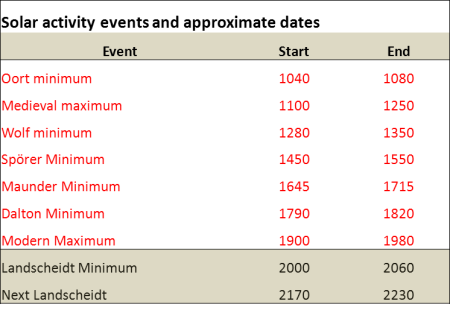I can see the evidence that the earth goes through warming and cooling cycles. But I have seen no evidence that man-made carbon dioxide emissions have had any significant impact on global climate in general or on global warming in particular. I am more inclined to the view that our climate is overwhelmingly dominated by the Sun – both directly with insolation variations and indirectly through the clouds and the oceans. Solar activity indicates we are approaching – or have arrived at – a new minimum, the Landscheidt Minimum – which will be similar to the Maunder Minimum. Another Little Ice Age in the next decade or two has always been on the cards.
(On a longer timescale, I believe a large volcanic eruption could be one of the possible triggers which tips the earth from interglacial to glacial conditions and our current interglacial cannot last more than another millennium or so.)
Now another model of the suns activity level also suggests that a Maunder-like Minimum and another Little Ice Age is just around the corner.
A new model of the Sun’s solar cycle is producing unprecedentedly accurate predictions of irregularities within the Sun’s 11-year heartbeat. The model draws on dynamo effects in two layers of the Sun, one close to the surface and one deep within its convection zone. Predictions from the model suggest that solar activity will fall by 60 per cent during the 2030s to conditions last seen during the ‘mini ice age’ that began in 1645. Results will be presented today by Prof Valentina Zharkova at the National Astronomy Meeting in Llandudno.
“We found magnetic wave components appearing in pairs, originating in two different layers in the Sun’s interior. They both have a frequency of approximately 11 years, although this frequency is slightly different, and they are offset in time. Over the cycle, the waves fluctuate between the northern and southern hemispheres of the Sun. Combining both waves together and comparing to real data for the current solar cycle, we found that our predictions showed an accuracy of 97%,” said Zharkova.
Zharkova and her colleagues derived their model using a technique called ‘principal component analysis’ of the magnetic field observations from the Wilcox Solar Observatory in California. They examined three solar cycles-worth of magnetic field activity, covering the period from 1976-2008. In addition, they compared their predictions to average sunspot numbers, another strong marker of solar activity. All the predictions and observations were closely matched.
Looking ahead to the next solar cycles, the model predicts that the pair of waves become increasingly offset during Cycle 25, which peaks in 2022. During Cycle 26, which covers the decade from 2030-2040, the two waves will become exactly out of synch and this will cause a significant reduction in solar activity.
“In cycle 26, the two waves exactly mirror each other – peaking at the same time but in opposite hemispheres of the Sun. Their interaction will be disruptive, or they will nearly cancel each other. We predict that this will lead to the properties of a ‘Maunder minimum’,” said Zharkova. “Effectively, when the waves are approximately in phase, they can show strong interaction, or resonance, and we have strong solar activity. When they are out of phase, we have solar minimums. When there is full phase separation, we have the conditions last seen during the Maunder minimum, 370 years ago.”
It really is time to acknowledge the Landscheidt Minimum:
Landscheidt also predicted that after the next solar minimum in 2030 the following minimum would occur in 2200.
It is perhaps time to officially name this minimum that is coming as the “Landscheidt Minimum”.
Tags: Landscheidt Minimum, Maunder Minimum, solar effects on climate

July 13, 2015 at 3:45 pm
[…] Minimum. Another Little Ice Age in the next decade or two has always been on the cards. – Click here to read the full article […]